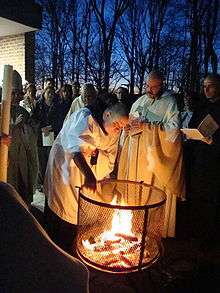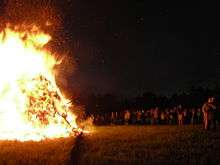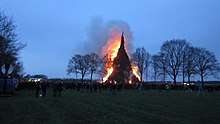Easter Fire
Easter fires are typically bonfires lit at Easter as part of liturgical and secular celebrations.

Liturgy
Fire can feature prominently during solemn Easter Vigil celebrations held after sunset on Holy Saturday, concluding the Paschal Triduum. Such a fire might be used to light a Paschal candle or other candles used symbolically before or during mass or other religious celebration.[1][2][3]
As a sacrament in remembrance of the Resurrection of Jesus, the Catholic mass according to Roman rite begins with a big celebration of light (Lucernarium): an open fire is lighted outside the church and blessed by the priest; when the Paschal candle is lit, the community ceremoniously enters the dark church chanting Lumen Christi and Deo gratias. The present-day rite normally follows the 1955 liturgical reforms of Pope Pius XII and the Summorum Pontificum of 2007. While the Old Catholic rite deviates only in a few points, traditional Protestant (Lutheran) celebrations excluded fire blessings. According to the Eastern Orthodox tradition of the Holy Fire, worshippers light candles from the Paschal trikirion during service at Saturday Midnight, while the troparion is sung.
Customs
On Holy Saturday or Easter Sunday, in rare occasions also on Easter Monday, large fires are lit at dusk in numerous sections of Northwestern Europe. These regions include Denmark, parts of Sweden as well as in Finland, Germany, some eastern provinces in the Netherlands, Switzerland, and Austria.
Though not documented before the 16th century, the custom presumably is based on Saxon, pre-Christian traditions, that are still performed each year. There are several explanations of the meaning of these fires. The Saxons probably believed that around the time of Easter, Spring becomes victorious over Winter. The fires were supposed to help chase the darkness and winter away. It was also a symbol of fertility, which works in a literal sense in that the ashes were scattered over the meadows and thereby fertilized the soil. Another possible origin of the Easter fire is that of St. Patrick lighting an unquenchable "High King" fire in defiance of the throne on the night before Easter of 432AD. The fire is symbolic of the undimmed light of Christ despite the pagan government's attempts to put it out and marked the beginning of the conversion of Ireland to Christianity. This fire reminds Christianity of the Eternal High Kingship of Christ. [4] The pre-Christian meaning of Easter fires is hardly experienced anymore. Nowadays they are meant to bring the community together, which guarantees a pleasant night combined with the consumption of beer, mulled wine or liquor, and snacks.

In Northern Germany, Easter Fires (German: Osterfeuer, ![]()

In some Old Bavarian regions, the Burning of Judas on Holy Saturday is still common. In the East Alpine regions of Austria, fires are traditionally part of Easter Vigil celebrations and usually lit widely visible on mountain slopes. Nevertheless, they are also restricted in some cities and districts to hold down the resulting annual peak of particulates immission.
Some municipalities in the Netherlands hold an annual competition to build the highest, or the neatest fire. The hamlet of Espelo in the municipality of Rijssen-Holten holds the world record with an Easter fire that measured 45.98 metres (150.9 ft) high. Most of these fires take place in the provinces of Drenthe, Groningen, and Gelderland, with the largest being in Twente, a part of Overijssel.
In Fredericksburg, Texas, each year the residents have Easter Fires the night before Easter, commemorating a peace treaty with the Comanche Indians. In 1847 when the original treaty was signed, the Comanches lit signal fires on the area hills. One mother calmed her children's fears, telling them the smoke came from the Easter Bunny who was dyeing eggs.[5]
See also
- Victimae paschali laudes
- Luminaria (vigil fire)
- Burgbrennen (very similar custom in Luxembourg)
- Funkenfeuer (similar custom in Swabian-Alemannic area)
- Feuerrad (similar custom in Westphalia, Hesse, Bavaria, Switzerland)
- Hüttenbrennen (similar custom in the Eifel)
- Sechseläuten (similar Swiss custom in Zürich)
- Biikebrennen (similar custom in North Frisia)
References
- "spirituality and worship". Liturgy. 2008-02-09. Retrieved 2013-12-30.
- "Trinity Episcopal Church". Photos.trinityjanesville.org. 2009-12-24. Retrieved 2013-12-30.
- "Old St. Mary's Church". Oldstmarys.org. 2006-01-29. Archived from the original on 2012-02-18. Retrieved 2013-12-30.
- "Saint Patrick And The Easter Fire". pauline.leadpages.co. Retrieved 17 June 2019.
- Texas State Historical Commission. "The Easter Fires". Historical Marker.
External links
| Wikimedia Commons has media related to Easter fires. |
- Paasvuursite (Easter Fire Site) (Dutch)